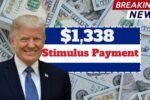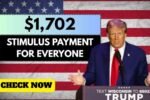Across the United States, many households continue to feel the unrelenting pressure of high living costs. Rising grocery prices, soaring rent, inflated utility bills, and general inflation have stretched family budgets to their breaking point. For millions, simply making it from one paycheck to the next feels like an uphill battle. In the midst of these economic struggles, there’s finally a bit of good news: the federal government is preparing to roll out a new $1,390 IRS Stimulus Check in 2025.
Expected to begin distribution in the summer of 2025, this payment will be issued directly by the Internal Revenue Service (IRS) to qualifying Americans. The goal is simple yet powerful—offer direct, tax-free financial relief to individuals and families who are most impacted by today’s economic climate.
For those who qualify, the $1,390 IRS Stimulus Check won’t just be a number on paper—it will represent the chance to catch up on overdue bills, stock up on essentials, or simply breathe a little easier in the face of constant financial strain.
$6,000 Stimulus Check In 2025- Who’s Eligible And How To Claim It
Why This Stimulus Check Matters
When the government steps in to provide direct cash payments to its citizens, it’s almost always in response to extraordinary circumstances. This time is no different. The lingering effects of inflation have caused everything from food to fuel to cost more, while wage growth for many has failed to keep pace.
The $1,390 IRS Stimulus Check is designed to offer targeted relief to low- and middle-income households—the groups most at risk of being squeezed out of financial stability. What makes this payment particularly attractive is that it is completely tax-free. That means recipients can use the entire amount without worrying about deductions come tax season.
Even better, the payment won’t interfere with most existing public assistance programs. If you’re receiving benefits such as Medicaid, SNAP (food stamps), or housing assistance, you’ll still be eligible to receive and keep the full stimulus amount. The intent is to provide extra support, not to create a bureaucratic trade-off.
Who Qualifies for the $1,390 IRS Stimulus Check?
The IRS will not be sending this payment to everyone—specific eligibility requirements are in place to ensure it reaches those who need it most. Here’s a clear breakdown of the criteria:
Income Limits
-
Single Filers: Annual income must be $75,000 or less.
-
Married Couples Filing Jointly: Combined annual income must be $150,000 or less.
-
Heads of Household: Annual income must be $112,500 or less.
If you’ve received a federal stimulus payment in previous years and your income hasn’t changed significantly, you’ll likely meet the criteria again this time.
Other Key Requirements
-
Must be a U.S. citizen or legal permanent resident.
-
Must have a valid Social Security number.
-
Must have filed a 2023 or 2024 federal tax return (unless you qualify through certain federal benefit programs).
-
Cannot be claimed as a dependent on someone else’s tax return.
When Will the Payments Be Sent?
While the federal government hasn’t announced an official payment start date, the current expectation is that the $1,390 IRS Stimulus Check will begin reaching eligible recipients by mid-summer 2025.
The IRS will follow its standard rollout pattern:
-
Direct Deposit First – People with their bank account information already on file will receive the payment first, often within days of distribution starting.
-
Paper Checks Next – Those who don’t have direct deposit set up will receive a paper check in the mail. This can take a few extra weeks.
-
EIP Debit Cards for Some – Certain recipients may receive their funds on an Economic Impact Payment (EIP) debit card, which will arrive via mail in a secure envelope.
How the Payment Will Be Delivered
The IRS has outlined three main delivery methods for the $1,390 IRS Stimulus Check:
1. Direct Deposit
This is the fastest and most secure option. The funds go straight into your bank account, often appearing within hours after the IRS sends them. If you’ve received previous tax refunds or stimulus payments this way, you don’t need to do anything—your payment will be sent to the same account.
2. Paper Check
For those without a direct deposit account on file, the IRS will mail a paper check to the address listed on your most recent tax return. While safe, this method can take longer due to postal delivery times.
3. EIP Debit Card
In some cases, the IRS will load the payment onto a prepaid debit card. This card will be mailed in a plain envelope from the U.S. Department of the Treasury. It can be used like a regular debit card for purchases, bill payments, or ATM withdrawals.
How to Make Sure You Get Paid on Time
If you want to avoid delays, here’s what you should do now:
-
Update Your Bank Information – Log in to the IRS portal at irs.gov to make sure your direct deposit details are accurate.
-
Confirm Your Mailing Address – If you’ve moved recently, update your address with both the IRS and the U.S. Postal Service.
-
File Your Taxes Promptly – If you haven’t filed your 2024 tax return yet, do so as soon as possible. The IRS uses your latest return to determine eligibility.
Beware of Scams
Unfortunately, large-scale relief programs like the $1,390 IRS Stimulus Check tend to attract scammers. These criminals often impersonate IRS officials, promising to “speed up” your payment or asking for personal details.
Red flags to watch out for:
-
Emails, calls, or texts claiming to be from the IRS asking for your Social Security number, bank account info, or a “processing fee.”
-
Websites that look like the IRS but have slightly misspelled URLs.
-
Messages urging you to “claim your stimulus” through unofficial links.
Important: The IRS will never contact you via text, email, or social media to request personal or financial information. If you’re unsure about a message, go directly to irs.gov or call the IRS through an official phone number.
Why This $1,390 Matters
For many households, $1,390 might not sound like a huge sum, but in times of financial stress, it can be transformative. Here’s how people might use it:
-
Paying down overdue rent or mortgage payments.
-
Covering rising utility bills.
-
Stocking up on groceries and essentials.
-
Handling emergency car repairs or medical expenses.
-
Setting aside for an emergency savings fund.
Given that this payment is tax-free and won’t reduce most existing benefits, recipients can apply it directly toward their most urgent needs without worrying about penalties or offsets.
Government’s Larger Goal
The $1,390 IRS Stimulus Check isn’t just about helping individuals—it’s part of a broader economic strategy. Direct payments have been shown to stimulate local economies because recipients typically spend the money quickly on goods and services in their communities. This ripple effect can help small businesses stay afloat and maintain jobs.
In addition, targeting low- and middle-income households ensures that the relief goes where it will have the greatest impact, rather than being absorbed into savings accounts that won’t immediately circulate through the economy.
Steps You Should Take Right Now
If you believe you qualify, here’s a simple checklist to follow:
-
Check Eligibility – Compare your 2023 or 2024 income to the thresholds listed above.
-
File Your Taxes – If you haven’t filed yet, do it as soon as possible.
-
Update Contact Info – Make sure the IRS has your correct mailing address and/or bank account details.
-
Monitor IRS Announcements – Keep an eye on irs.gov for official payment date updates.
-
Stay Scam-Smart – Never share personal information with anyone claiming to speed up your payment.
Conclusion: Relief Is on the Way
The upcoming $1,390 IRS Stimulus Check is more than just another government program—it’s a financial lifeline for millions. In an era where every dollar counts, this payment can help families cover essentials, reduce debt, or build a small cushion for the future.
If you meet the requirements, take the necessary steps now to ensure you receive your payment promptly. And remember, while this relief is temporary, smart use of these funds can provide lasting benefits in your financial journey.
FAQs
Q: Who is eligible for the $1,390 IRS Stimulus Check?
A: Single filers earning $75,000 or less, married couples filing jointly earning $150,000 or less, and heads of household earning $112,500 or less, provided they have a valid SSN and have filed recent tax returns.
Q: Will I have to pay taxes on this check?
A: No. The $1,390 IRS Stimulus Check is entirely tax-free and will not be counted as income on your next tax return.
Q: When will the payments start?
A: Expected in mid-summer 2025, with direct deposit recipients receiving theirs first, followed by paper checks and debit cards.
Some Important Link
| Download News APP | Click Here |
| WhatsApp Group | Click Here |
| Home Page | Click Here |





